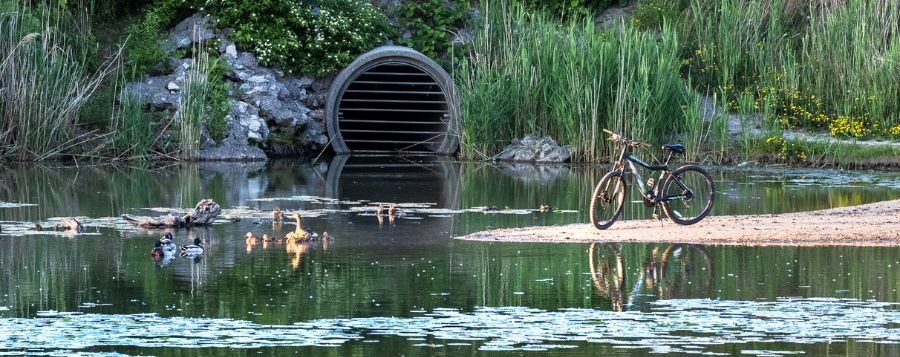Subscribe to our Newsletter
Sign up to receive semi-annual updates on various current and proposed environmental issues including air quality, hazardous waste & water, industrial hygiene, and more.
Major Changes Take Effect on Industrial Storm Water Permit
August 17, 2020

*The information in this article is based on California’s IGP as of August 17, 2020. Please verify current guidelines and regulations independently.
California’s “Industrial General Permit” (IGP), which regulates pollutants in storm water discharges from many industrial facilities statewide, has been amended effective July 1, 2020. The changes may have major implications for dischargers – mainly in Southern California – that discharge to “impaired” water bodies or watersheds. The IGP already applies Numeric Action Levels (NALs) to a group of pollutants that may be found in a facility’s storm water discharge. When a facility’s storm water sampling results exceed a NAL, the facility must take actions to better control that pollutant. The same 23 NALs are applied throughout California.
However, the various Regional Water Quality Control Boards have now developed additional water body-specific (or in some cases, watershed-specific) regulatory levels. These apply only to facilities that discharge storm water to a specified water body or watershed. In all cases, this does not need to be a direct discharge. Facilities that discharge to a municipal storm sewer that, in turn, discharges to the impaired water body or watershed are also subject to the new regulatory levels. The affected water bodies and watersheds are primarily, although not exclusively, located in Southern California.
The IGP amendments set two types of new regulatory levels for a group of water bodies and watersheds, mainly in Southern California. These new levels are published in Attachment E of the amended IGP. The regulatory levels are specific to water bodies/watersheds and are different for each water body and watershed. Because these new levels were put in place only for a minority of water bodies and watersheds in California, it is critical to understand where your facility’s storm water is discharging and then use that information to review Attachment E, available online at:
https://www.waterboards.ca.gov/water_issues/programs/stormwater/docs/industrial/unoff_igp_amend.pdf.
The first new type of regulatory level, known as a Total Maximum Daily Load (TMDL) NAL or “TNAL,” is similar in its effect to the current NALs. When a TNAL value is exceeded, a facility will perform Exceedance Response Actions (ERAs) using the Level 1 and Level 2 ERA processes in the IGP. However, the new TNAL values are frequently lower than current NAL values. TNALs are also set for pollutants that do not currently have a NAL at all.
In addition to TNALs, the Regional Boards may also specify, for certain watersheds, Numeric Effluent Limits (NELs). Unlike NALs and TNALs, a facility whose pollutant concentrations in storm water exceed an NEL is in violation of the IGP. Facilities will face penalties for such violations and will be required to take actions as necessary to prevent future exceedances. Because the IGP is a federally enforceable permit, this presents a real risk to facilities operating in watersheds where NELs will be established.
Other permit changes address solutions to TNAL and NEL exceedances, particularly focusing on various storm water capture methods. In accordance with Attachment I of the amended IGP, certain types of storm water capture systems, when designed to specific criteria, may allow a discharger to demonstrate compliance with the NELs (and NALs and TNALs also). Because installing such systems may be an extended project, the Regional Boards are negotiating what are known as Time Schedule Orders (TSOs) with dischargers who may want to shield themselves from NEL exceedances during the time it takes to install their capture system.
________________________________
Yorke Engineering has assisted over 2,000 industrial and government facilities across California with EH&S consulting and air quality consulting, as well as permitting and compliance for storm water, wastewater, hazardous waste, industrial hygiene, and safety programs. Learn more here: Services – Yorke Engineering, LLC
If you would like a proposal, click the button below.
Waste & Water Tip
As part of Senate Bill (SB) 205, which took effect January 1st, when applying for or renewing a business license with a City or County, the Business and Professions Code 16100.3 now requires businesses in covered Standard Industrial Classification (SIC) Codes to demonstrate compliance with a storm water discharge permit program by providing either their Waste Discharger Identification (WDID) No. showing full IGP coverage; WDID Application No.; Notice of Non-Applicability (NONA) ID No.; or No Exposure Certification (NEC) No. For more info, visit: https://www.waterboards.ca.gov/water_issues/programs/stormwater/sb_205_business_license_requirements.html
View our informative archived Newsletters ...
SCAQMD
January 2023
September 2022
February 2022
September 2021
January 2021
August 2020
January 2020
September 2019
January 2019
August 2018
January 2018
August 2017
December 2016
August 2016
February 2016
August 2015
December 2014
September 2014
January 2014
February 2013
July 2012
February 2012
December 2011
August 2011
June 2011
January 2011
BAAQMD
September 2022
February 2022
September 2021
January 2021
August 2020
January 2020
September 2019
January 2019
August 2018
January 2018
August 2017
December 2016
August 2016
February 2016
August 2015
January 2015
August 2014
February 2014
January 2013
July 2012
December 2011
August 2011
SJVAPCD
September 2022
February 2022
September 2021
January 2021
August 2020
January 2020
September 2019
January 2019
August 2018
January 2018
August 2017
January 2017
August 2016
February 2016
August 2015
January 2015
August 2014
January 2014
February 2013
July 2012
February 2012
December 2011
August 2011
